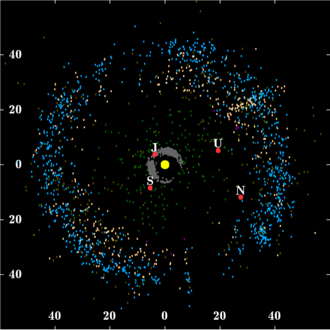An editor has nominated this article for deletion. You are welcome to participate in the deletion discussion , which will decide whether or not to retain it. |


| Sun Jupiter trojans Orbits of planets | Asteroid belt Hilda asteroids (Hildas) Near-Earth objects (selection) |

| Sun Jupiter trojans Giant planets: Centaurs | Neptune trojans Resonant Kuiper belt Classical Kuiper belt Scattered disc |
Solar System belts are asteroid and comet belts that orbit the Sun in the Solar System in interplanetary space. [1] [2] The Solar System belts' size and placement are mostly a result of the Solar System having four giant planets: Jupiter, Saturn, Uranus and Neptune far from the Sun. The giant planets must be in the correct place, not too close or too far from the star for a system to have Solar System belts. [3] [4] [5]



